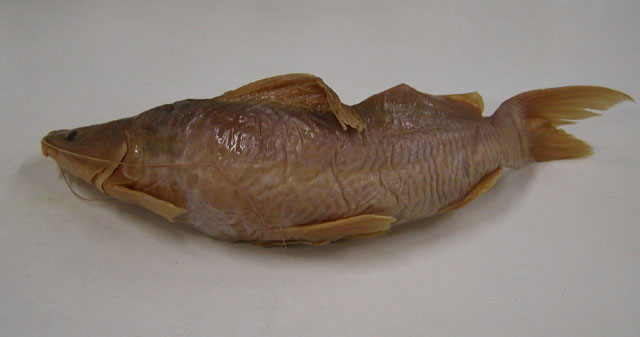| Bagridae (Bagrid catfishes) |
| 44.7 cm TL (male/unsexed) |
|
demersal; freshwater |
| Africa: River Pangani (Tanzania)(Ref. 3236) and Lake Chiuta (Ref. 46841). |
|
Dorsal spines (total): 1-1; Dorsal soft rays (total): 9-10; Anal soft rays: 13-14. Head much depressed, smooth above or finely striated on sides of elongate fontanelle; premaxillary band of teeth 5-6 times as long as broad, nearly as broad as the band of vomerine teeth; snout truncate (Ref. 2988). Snout projecting beyond lower jaw (Ref. 52162, Ref. 2988). Maxillary barbel 1.66-2 times head length, reaching pelvics (Ref. 52162), but not passing the base of the pelvics (Ref. 1884). Nasal barbel 1/5-1/3 of head length; inner mandibular barbel 0.33-0.4 times head length (Ref. 2988). Outer mandibular barbel 0.60-0.66 times head length (Ref. 52162, Ref. 2988). Occipital processus long and narrow, almost reaching the interneural (Ref. 52249). Last ray of dorsal fin above vertical of first ray of pelvics; dorsal spine smooth, feeble; adipose fin 4-5.5 times as long as deep, about twice as long as dorsal fin; caudal fin deeply forked, with pointed lobes (Ref. 2988). Upper lobe of caudal fin with short filament (Ref. 52249). Pectoral spine moderately strong, smooth, or very slightly serrated behind (Ref. 2988).
Coloration: brown or olive above, white beneath; black dots sometimes scattered on the back and on the adipose and caudal fins (Ref. 2988). |
| Present in the deeper waters of large rivers (Ref. 4967). |
|
Least Concern (LC); Date assessed: 01 May 2009 Ref. (130435)
|
| harmless |
Source and more info: www.fishbase.org. For personal, classroom, and other internal use only. Not for publication.
